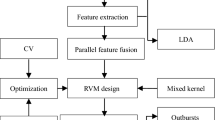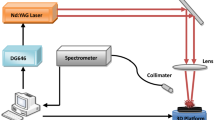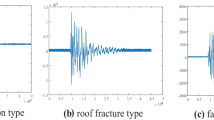Abstract
Due to the severity and great harm of coal and gas outbursts accidents, outbursts prediction becomes very necessary; the paper presents a hybrid prediction model of feature extraction and pattern classification for coal and gas outbursts. First, discrete wavelet transform (DWT) is utilized as a preprocessing technique to decompose subseries and extract the features with different frequencies and the optimal feature components are retained; second, in order to eliminate the redundancy between the features and uncorrelation between features and outbursts, we use the fast independent component analysis (FICA) to obtain each independent component, obtaining the global information in the feature; then, the obtained features are input into linear discriminant analysis (LDA), under the guidance of class labels, then the local information in features is obtained; finally, the projected features are input into the deep extreme learning machine (DELM) classifier based on the optimal parameters by quantum particle swarm optimization (QPSO) for training and classification. The experimental results on the dataset of coal and gas outbursts show that compared with other models in the current prediction of coal and gas outbursts, this method has significant effect on various indicators.








Similar content being viewed by others
Availability of data and material
The raw/processed data required to reproduce these findings cannot be shared at this time as the data also form part of an ongoing study. Some or all data, models, or code generated or used during the study are available from the corresponding author by request.
References
Chen KP (2011) A new mechanistic model for prediction of instantaneous coal outbursts Dedicated to the memory of Prof. Daniel D. Joseph. Inter J Coal Geol 87(2):72–79.
Cunquan N, Xiating F (2005) Coal and gas outburst area prediction using SVM. Chin J Rock Mechan Eng 24(2):263–267
Wang W, Ding J (2003) Wavelet network model and its application to the prediction of hydrology. Nat Sci 1:67–71
Tan Z, Zhang J, Wang J, Xu J (2010) Day-ahead electricity price forecasting using wavelet transform combined with ARIMA and GARCH models. Appl Energy 87(11):3606–3610
Daubechiesi. (1992) Ten lectures on wavelets, 61. SIAM, Philadelphia
Zhu Zj, Zhang HW, Han J, Song WH (2013) Prediction of coal and gas outburst based on PCA-BP neural network. China Safety Sci J 23:45–51
Fu H, Wang X, Wang Z (2014) Research on the soft sensor of coal and gas outburst based on PCA and PSO-ELM. Chinese J Sens Actuators 27(12):1710–1715
Li D (2009) Research on prediction of coal and gas outburst based on ICA-SVM. Industry and Mine Automation 10:36–39
Gao W (2010) The application of fisher discriminant in predicting dangerous level of coal and gas outburst. China Safety Sci J 20(10):26–31
Wen T, Zhang B, Shao L (2014) Prediction of coal and gas outburst based on random forest model. Comput Eng Appl 50(10):233–238
Long NZ, Yi AM, A XJ, Zhang XL (2019) Prediction of coal and gas outburst intensity based on LLE-FOA-BP model. Ind Mine Autom 45(10):68–74
Wang Y, Wang, Fu H, Zhang Y (2015) The identification model of coal and gas outburst intensity based on KPCA and CIPSO-PNN. Chinese J Sens Actuators 28(2):272–279
Li S, Hu H (2017) Risk identification of coal and gas outburst based on KPCA and improved extreme learning machine model. Appl Res Computers 35(1):172–177
Kang F, Xu W, Zhang S (2014) A novel hybrid KPCA and SVM with GA model for intrusion detection. Appl Soft Comput 18:178–184
Fu H, Feng S, Gao Z, Yang Y (2018) Study on double coupling algorithm Based model for coal and gas outburst prediction. China Safety Sci J 28(3):84–90
Liang B, Qin B, Sun W, Wang S, Shi Y (2013) The application of intelligent weighting grey target decision model in the assessment of coal-gas outburst. J China Coal Soc 38(7):1611–1615
Yan X, Fu H, Chen W (2014) Prediction of coal mine gas emission based on Markov chain improving IGA-BP mode. Computer Model New Technol 10:2–24
Kuang F, Jin Z, Xu W (2014) A novel chaotic artificial bee colony algorithm based on Tent map. In: 2014 IEEE congress on evolutionary computation (CEC) 235–241.
Hoang ND, Bui DT (2016) A novel relevance vector machine classifier with cuckoo search optimization for spatial prediction of landslides. J Comput Civ Eng 30(5):1943–5487
Ahilaa R, Sadasivamb V, Manimalaa K (2015) An integrated PSO for parameter determination and feature selection of ELM and its application in classification of power system disturbances. Appl Soft Comput 32:23–37
Liying P, Fan G (2016) Hybridizing DEMD and quantum PSO with SVR in electric load forecasting. Energ 22(1):1–20
Santoso S, Grady WM, Powers EJ, Lamoure J, Bhatt SC (2000) Characterization of distribution power quality events with Fourier and Wavelet transforms. IEEE Trans Power Deliv 15(1):245–247
Gaouda M, Salama MMA, Sultan MR, Chikhani AY (1999) Power quality detection and classification using wavelet multiresolution signal decomposition. IEEE Trans Power Deliv 14(4):1469–1476
Mário O, Coury Denis V, Delmont FO, Usida Wesley F, Adriano AFM, Carneiro, et al (2009) Power quality analysis applying a hybrid methodology with wavelet transforms and neural networks. Int J Electr Power Energy Syst 31(5):206–212
Subasi A, Gursoy MI (2010) EEG signal classification using PCA, ICA, LDA and support vector machines. Expert Syst Appl 37(12):8659–8666
Kao L-J et al (2013) Integration of nonlinear independent component analysis and support vector regression for stock price forecasting. Neurocomputing 99:534–542
HYVARINEN (1999) A. Fast and robust fixed-point algorithms for independent component analysis. IEEE Trans Neural Netw 10(3): 626–634.
Wei Z, Yuanliang H, Zhenzhen H et al (2017) Research on implementation method of LDA algorithm based on Particle Swarm Optimization. Comput Eng Appl 53(1):39–43
Liu L, Yang H, Xiao G (2019) Time-frequency domain feature extraction algorithm based on linear discriminant analysis. Syst Eng Electronic 2(7):14–19
Sijing D, Zhong S, Sun Y, Yanku. (2019) Combining principal component analysis network with linear discriminant analysis for the classification of retinal optical coherence tomography images. J Image Graphic 24(01):0115–0123
Huang GB, Zhou HM, Ding XJ, Zhang R (2012) Extreme learning machine for regression and multiclass classification. IEEE Trans Syst Man Cybern B Cybern 42(2):345–367
Xu SuHui Mu, XiaoDong CD, Chang L (2018) Domain adaption algorithm with ELM parameter transfer. Acta automatic sinica 44(2):311–317
Ding SF, Xu XZ, NIER. (2014) Extreme Learning Machine and Its Applications. Neural Comput Appl 25(34):549–556
JiaMing Xu, WeiQiang Z (2015) Manifold regularized extreme learning machine for language recognition. Acta automatic sinica 41(9):234–250
Shan Dong Xu, Xinzheng. (2017) Multi-label learning model based on multi-label radial basis function neural network and regularized extreme learning machine. PR&AI 30(9):833–840
Uzair M, Shafait F, Ghanem B et al (2015) Representation learning with deep extreme learning machines for efficient image set classification. MACINTYRE. J Neural Computing Appl London: Springer 1:1–13
Sudheer Ch, Nitin Anand BK, Panigrahi SM (2013) Streamflow forecasting by SVM with quantum behaved particle swarm optimization. Neurocomputing 101:18–23
Zhang Y, Cui J, Jiao X (2018) Study of the multi-index coupling forecasting model of coal and gas outburst and its application. Chinese J Eng 40(11):1309–1316
Alpar O (2018) Online signature verification by continuous wavelet transformation of speed signals. Expert Syst Appl 104(3):33–42
Lili Huang, Jun Wang (2018) Forecasting energy fluctuation model by wavelet decomposition and stochastic recurrent wavelet neural network. Neurocomputing.309:70–82.
Acknowledgements
This research was supported by the National Natural Science Foundation of China (U1704242); the authors of this paper would like to thank the insightful and valuable comments from Hebei Key Laboratory of IOT blockchain integration.
Author information
Authors and Affiliations
Corresponding author
Ethics declarations
Conflict of interest
The authors declare no competing financial interest.
Additional information
Publisher's Note
Springer Nature remains neutral with regard to jurisdictional claims in published maps and institutional affiliations.
Rights and permissions
About this article
Cite this article
Liu, X., Li, Z., Zhang, Z. et al. Coal and gas outbursts prediction based on combination of hybrid feature extraction DWT+FICA–LDA and optimized QPSO-DELM classifier. J Supercomput 78, 2909–2936 (2022). https://doi.org/10.1007/s11227-021-03964-5
Accepted:
Published:
Issue Date:
DOI: https://doi.org/10.1007/s11227-021-03964-5




